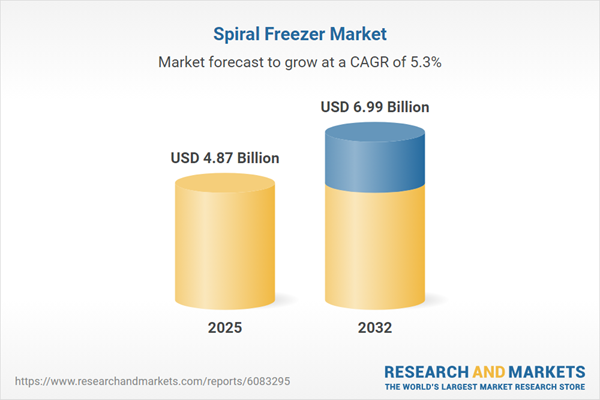Speak directly to the analyst to clarify any post sales queries you may have.
Spiral freezer solutions are transforming modern food processing by enhancing product consistency, optimizing operations, and supporting high standards in safety and quality. Market adoption is accelerating due to the evolving regulatory landscape, technological advancements, and shifting global supply chain demands.
Market Snapshot: Spiral Freezer Market
The spiral freezer market is on track for steady growth, set to expand from USD 4.62 billion in 2024 to USD 4.87 billion in 2025, and forecast to reach USD 6.99 billion by 2032, reflecting a CAGR of 5.30%. This upward trajectory highlights the increasing value placed on advanced freezing technology across food manufacturing, as sector leaders seek to balance efficiency, regulatory compliance, and the need for consistent product quality. The sustained momentum signals enduring demand for automated, scalable, and energy-efficient freezing systems, shaping investment strategies throughout the supply chain.
Scope & Segmentation
This comprehensive report equips senior decision-makers, technology integrators, and food processing executives with in-depth insight across all major segments of the spiral freezer market. Segment coverage includes:
- Type: Double spiral, single spiral, and triple spiral freezer models provide adaptable options for businesses with varying production capacities and facility layouts.
- End User Industry: Solutions apply to sectors such as bakery and pastry, fruits and vegetables, meat and poultry, ready meals, convenience foods, and seafood processing, each with distinct product handling and shelf life requirements.
- Operation Mode: Automatic, semi-automatic, and manual configurations are available, enabling alignment with workforce skills and efficiency goals, and supporting transitions from basic to fully automated lines.
- Capacity: Equipment selections range from under 5 tons per hour to above 10 tons per hour, ensuring suitability for everything from niche production settings to large-scale industrial plants.
- Sales Channel: Multiple procurement routes are addressed, including direct sales, distributor networks, dealer relationships, and online purchasing methods, each designed to streamline access and tailor post-sales support.
- Function: Units are equipped for freezing only, freezing and proofing, or freezing and thawing, accommodating integrated food processing needs while enhancing plant versatility.
- Geographic Coverage: Analysis spans the Americas, Europe, Middle East and Africa, and Asia-Pacific, factoring in region-specific regulations, infrastructure development, and market entry strategies.
- Company Coverage: The market landscape is defined by JBT Corporation, GEA Group Aktiengesellschaft, Technofrigo S.p.A., Airblast Limited, Unitherm Food Systems, Air Systems International, Technicold S.p.A., Marel hf., Fomaco A/S, and Meyn Food Processing Technology B.V.
Key Takeaways for Senior Decision-Makers
- Spiral freezer systems reinforce process reliability and boost throughput for critical food sectors, allowing leaders to maintain consistent quality even with demand fluctuations or tight production schedules.
- Technologies such as IoT-enabled monitoring and predictive analytics are being embedded into new systems, supporting lean manufacturing and reducing operational costs by improving resource utilization and minimizing unplanned downtime.
- Innovative refrigerant options and integrated heat recovery solutions help organizations meet sustainability and emission goals while managing energy-related expenses.
- Modular, scalable freezer platforms allow small and mid-sized producers to invest incrementally, minimizing operational disruption when expanding production capacity.
- Regional variations in regulatory expectations, from rigorous traceability standards in North America to evolving compliance demands in Asia-Pacific, are prompting tailored adoption approaches and localized strategies for market access.
Tariff Impact and Strategic Sourcing
Recent tariff measures in the United States have resulted in higher costs for essential spiral freezer parts, including stainless steel modules and refrigeration controls. These conditions have prompted manufacturers to reassess supply chains, diversify sourcing arrangements, and expand domestic assembly operations. As a consequence, many industry participants are negotiating new supplier contracts and increasing local inventories, ensuring more stable delivery timelines and procurement costs despite trade policy shifts.
Methodology & Data Sources
Market data and forecasts in this report are developed by aggregating validated information from peer-reviewed studies, industry association analyses, global equipment vendors, and direct interviews with refrigeration engineers and food plant managers. Quantitative insights are corroborated by expert surveys and peer review, providing executives with reliable market intelligence.
Why This Report Matters
- Empowers executive teams to make informed capital investments in digital controls, sustainable refrigerants, and modular expansion aligned with evolving facility needs.
- Delivers strategic analysis on compliance trends, sourcing best practices, and local adaptation measures to enhance supply chain agility.
- Supports market positioning with actionable forecasts and targeted technology insights for better risk mitigation and competitive planning.
Conclusion
Staying aligned with rapidly advancing freezing technologies and adjusting sourcing strategies equips organizations to adapt confidently in a dynamic market. Prioritizing flexibility and compliance can give market leaders a distinct advantage as new opportunities arise within the spiral freezer sector.
Table of Contents
3. Executive Summary
4. Market Overview
7. Cumulative Impact of Artificial Intelligence 2025
Companies Mentioned
The companies profiled in this Spiral Freezer market report include:- JBT Corporation
- GEA Group Aktiengesellschaft
- Technofrigo S.p.A.
- Airblast Limited
- Unitherm Food Systems, Inc.
- Air Systems International, Inc.
- Technicold S.p.A.
- Marel hf.
- Fomaco A/S
- Meyn Food Processing Technology B.V.
Table Information
| Report Attribute | Details |
|---|---|
| No. of Pages | 194 |
| Published | October 2025 |
| Forecast Period | 2025 - 2032 |
| Estimated Market Value ( USD | $ 4.87 Billion |
| Forecasted Market Value ( USD | $ 6.99 Billion |
| Compound Annual Growth Rate | 5.3% |
| Regions Covered | Global |
| No. of Companies Mentioned | 11 |









